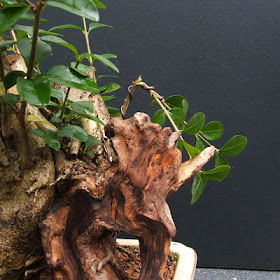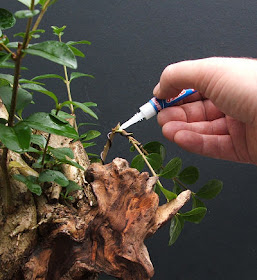
A favorite bonsai is blown off a bench during strong winds and several important branches get broken. Or, when wiring a tree, a branch is bent a little too far, and the branch snaps. Many things can actually happen when the tree is not indoor and then timing for a quick fix is crucial for the survival of the branch or even the entire tree.
Judging by the number of questions raised on the bonsai forums over the years, these are events that have happened to all of us at least once. Very often an enthusiast has tried to repair the branch themselves and though the cambium layer repairs itself, the wound keeps reopening and is a weak point in the branch.
So how do you successfully repair a snapped branch? Or does it just need to be removed and regrown? Though I have seen many repairs and remedies offered by fellow enthusiasts (ranging from the ridiculous to the sublime) the best way of repairing a snapped branch is extraordinarily simple. When there is a will there's a way! An easy example reflected below illustrates how to fix a snapped branch. Chances of recouping the branch are pretty high and I am not worried that in few months the tree will be back growing in full swing as it did from the very beginning.
I've snapped this thin privet branch and it shows a pretty typical scenario. As a two-year-old shoot, the wood is quite brittle so it has snapped on one side while being bent into position. If the branch is completely separated into two pieces, it cannot be repaired and should be pruned away and the wound cleaned up. However, if one side of the cambium layer (branch) is still attached naturally, it can literally be glued back together.
A spot of bonsai glue (any brand) is put onto the surface of the wood. As the callus forms, the paste drops off gradually without leaving marks. I have used this cut seal on my bonsai for a number of years and can not say enough about it. It is easy to apply covers nicely and blends in with the bonsai so as not to make it stand out. Highly recommend getting this to add to your bonsai supplies.
and the branch is glued back together. It really is as simple as that! The glue glues the woody parts of the branch together very tightly and supports the branch while the wound (and cambium layer) heals. Eventually, both sides of the snapped branch grow together; this can take as little as 3 or 4 weeks on vigorous branches during the growing season. I find that the repair is so strong that the branch can be manipulated (wired into position) within 5 minutes of the repair being made. The repair site will have lost its elasticity though, so don't not try to create a bend at that point.
 |
| Click on the image to for more information |
Any excess glue will dry a white color on the surrounding bark. It is unsightly so try to avoid using too much glue when making your repair but any excess will fall away naturally after a few months. Finally, always keep some bonsai glue to hand. If you do a lot of wiring you will find it becomes a valuable tool! I find that as thicker branches are stronger and more robust they tend to splinter rather than snap and so this article focuses on branches up to around 1/2" thick. However, repairs can be made using this technique with thicker branches. Bonsai glue is not poisonous to a tree and will not harm the tree or the branch, nor will split glue damage any leaves (it just looks awful). The glue can be used on woody or tender shoots. There is no need to wrap or protect the glued area on branches of less than 1/2", above this diameter, a thin spread of Vaseline over the damaged bark/cambium is more than sufficient. There is no need to wire the branch or for the branch to be wired for the repair to be successful. The fact is that bonsai glue dries very rapidly and will tolerate moisture (in the wood) which makes it so effective for repairing branches.
This technique can be used on all tree species; coniferous, deciduous or broad leaf tree during active growth or during dormancy. This is about it, that's all that it takes to repair a broken branch. I would appreciate your feedback and share your gluing experience with many bonsai enthusiasts around the world.
Interesting Books on Bonsai can be found here:
The Complete Book of Bonsai --> I've been into bonsai for 25 years and this is the basic Bible for beginner and intermediate bonsai enthusiasts. It has an excellent section on techniques, including pruning, wiring and whatnot, and it has a large species-specific tree guide. If you're into bonsai and want only one book, this is it.
Indoor Bonsai The Great Selection --> Creating beautiful, healthy bonsai is a wonderful skill that anyone can learn, with a little time, patience, and this all-inclusive manual. With color photos and drawings to illustrate the points, it introduces all the cultivation techniques; offers expert advice on location, soil types, watering, and pest control; and provides intricate instruction on training the bonsai--including pruning, wiring and stretching it.
The Secret Techniques of Bonsai --> In The Secret Techniques of Bonsai, the author of the groundbreaking Bonsai With American Trees teams up with his son to offer not only the basics for creating perfect bonsai, but also secret techniques they’ve developed over years of careful work and observation.
Bonsai Survival Manual --> Problem solving when your Bonsai get sick. Expand your gardening repertoire as you create a captivating and exquisite miniature world. In this introductory guide, Colin Lewis covers everything you need to know to design, grow, and successfully maintain attractive bonsai.
Bonsai and the art of Penjing --> Bonsai & Penjing, Ambassadors of Beauty and Peace describes how Chinese penjing and North American bonsai were later added to the Museum, making its collection the most comprehensive in the world. Stories of individual trees and forest plantings are featured, as are the roles played by the skilled and talented creators of these living art forms people such as John Naka, Saburo Kato, Yuji Yoshimura, Harry Hirao, and Dr. Yee-Sun Wu.
Bonsai and the art of Penjing --> Bonsai & Penjing, Ambassadors of Beauty and Peace describes how Chinese penjing and North American bonsai were later added to the Museum, making its collection the most comprehensive in the world. Stories of individual trees and forest plantings are featured, as are the roles played by the skilled and talented creators of these living art forms people such as John Naka, Saburo Kato, Yuji Yoshimura, Harry Hirao, and Dr. Yee-Sun Wu.
Bonsai with Japanese Maples --> With their delicate foliage, seasonal color changes, and intricate pattern of branching, Japanese maples are among the most popular and suitable plants for bonsai design. In this long-awaited book, internationally renowned expert Peter Adams discusses both the specific horticultural needs of Japanese maples as bonsai subjects and illustrates proven techniques for creating and maintaining beautiful specimens.
The Modern Bonsai Practice --> The most current, useful information on growing Bonsai. Fresh, practical, definitive, comprehensive reference guide to the finest art of horticulture: growing miniature trees. Common sense bonsai answers separating myth from fact with depth and detail. Appropriate for both bonsai hobbyists and experienced practitioners.





Hi The Little Bonsai Team,
ReplyDeleteMy name is Anuj Agarwal. I'm Founder of Feedspot.
I would like to personally congratulate you as your blog The Little Bonsai has been selected by our panelist as one of the Top 75 Bonsai Blogs on the web.
http://blog.feedspot.com/bonsai_blogs/
I personally give you a high-five and want to thank you for your contribution to this world. This is the most comprehensive list of Top 75 Bonsai Blogs on the internet and I’m honored to have you as part of this!
Also, you have the honor of displaying the badge on your blog.
Best,
Anuj
I have used Gorilla glue. But, that branch will never be as strong as an unbroken branch and this must be remembered when wiring that branch in the future.
ReplyDeleteSir,
ReplyDeleteI am in need this Bonsai glue. Please let me know where I can get this.....
Thanks
Shirolkar
bwshirolkar@gmail.com, 9422035895
Dear Shirolkar, you can get this Bonsai glue here http://amzn.to/2Elgm06
DeleteThank you